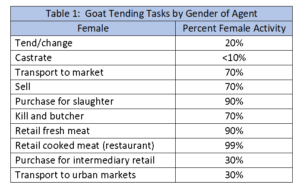Using the MEVMS value chain research and presentation strategy described here, this paper provides a rapid summary of the goat value chain in rural Haiti. The research is based on literature review, focus groups and a 405 household survey in the Grand Anse conducted in January 2018 on behalf of Heks-Eper; focus groups key informant interviews conducted in the NW on behalf of the UN organization IFAD in 2014; disseration research conducted in the 1990s in NW Haiti. [Go here for the Full HEKS EPER Report and here for HEKS EPER Value Chain Only Report and here to find the Focus Group Transcriptions and Translations.
Goat Ethnographic Value Chain in Haiti
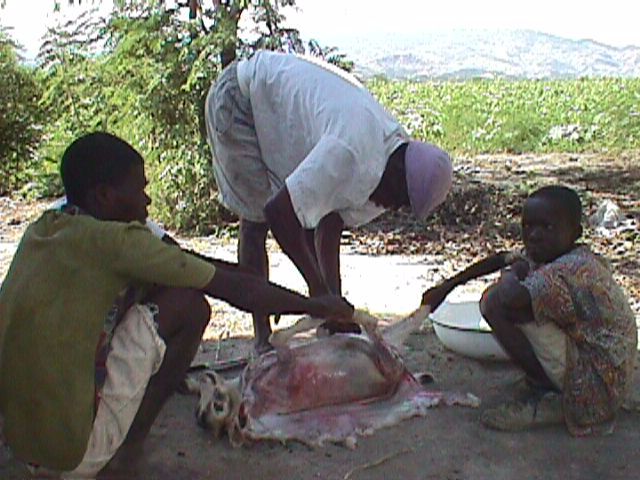
Distribution
After chickens, goats are the most common household animal in rural Haiti, with typically two to three per goats per rural household.
Types
Local goats and improved varieties, meaning imported stock, with no distinction made between different types within the local or imported goat categories. Goats are graded by age, baby goat, young goat, and adult.
Primary Stakeholders
The owner of the goat, consumers, “brase” (professional goat trader who will aggregate goats for resale).
Secondary stakeholders
Restaurant owners, barefoot veterinarians, government officials providing papers in market.
Production
Goats are minimally managed. People predominantly tie rather than corral or range the goats. They are only free-ranged for short periods of time after harvests. Goats in the Grand Anse are not branded. Rather people can demonstrate ownership by the fact that goats bond with and recognize their owners. They are sometimes bred deliberately, but also often simply ‘get bred’ on their own when a male breaks lose or takes advantage of being corralled. Bucks are sometimes castrated at 1 year of age to increase size and meat yield. They are not cut but rather the scrotum is pinched between two blacks of wood and their testicles are crushed with a rock.
Work organization
Organized around the household labor supply.
Package and Transport
The animals are typically transported live. One person can walk with 10 goats. One goat can be led and the others will follow. When transporting the animals to the city, they are simply hung by their feet, live, from the sides of the vehicle.
Processing and packing
- No specialists are needed to slaughter or butcher goats, the skills are common
- The animals are usually killed on market day
- Meat not sold is washed with sour oranges or lime, salted, sundried and then stored for household consumption. However, dried goat meat is not sold in the way that pork is sometimes dried and sold.
- The animal is sometimes quartered but often pieces are simply cut according to demand of client.
- All of the animal can be sold or is eaten: brains, intestines, blood, marrow, bone, and sometimes even skin. Bones in the feet are sold to play a child’s game known as Wosle (similar to jacks). Only hooves, horns, and crushed bone are discarded.
Technology
Knife and machete. Bucks are “castrated” by smashing their testicles with a rock.
Tenure
Households typically own their own goats. However, better off individuals will tenure goats out to others: the arrangement is that they share any medical expenses. The offspring are shared 50/50. Although life expectancy is ~10 years, the typical goat in rural Haiti only lives to be 2 to 3 years of age and then either slaughtered or sold for slaughter.
Hiring
All is done with household labor except sometimes slaughter and processing. Killing is not considered an exceptional skill. Anyone may slaughter a goat. Even children might slaughter a goat. Women more often than men butcher the animals. The pay for butchering a goat is ½ to all of the neck meat.
Financial underwriters
Aid agencies have participated in underwriting the costs of importing improved stock and subsidizing vaccination campaigns. Goat meat might be sold on credit but not live goats.
Source of financing to Purchases Goats
Principally gardens and livestock and to a lesser extent fishing.
Sales
The pattern is for households to purchase young female goats, care for them until they have a litter, and then sell the offspring before they begin to reproduce. The woman of the household might sell the goat live or slaughter the goat and retail the meat in the market on the neighborhood. However, selling meat can be risky as she might not find enough customers.
- Goats are sold primarily for the following reasons
- Food expenses
- Medical bills
- School Tuition
- Finance the Planting of a Garden
- Purchase fishing gear/traps
- Invest in Commerce
People will occasionally slaughter a goat for household consumption. Primary reasons goats are killed for household consumption is
- Ceremonial sacrifice or
- Consumption associated with the birth of a human baby
Market Venue
Goats are sold in the livestock section of open markets. There are no slaughter houses. Goats are killed anywhere there is ground and outside of houses or buildings. The meat is sold in the markets, by the street or the woman may walk with the meat and try to sell it.
Consumers
Goat meat is detailed out by the piece to purchasers for household consumption or to informal restaurants or cooks.
Measure
Goat meat is sold by volume, with no standard measuring instrument.
Prices and Profits (Value added line)
Goat traders are known as “Brase”. A typical Brase can handle about 10 to 12 goats, worth about 10,000 to 15,000 goud. Goats are most expensive during times of celebrations, December and January when there are religious celebrations, and March through July when children have First Communions. They are least expensive in September when parents tend to sell goats to pay school tuition. The increase in value from rural area to Jeremy is 50%; the increase to Port-au-Prince is 100%. There is a significant price differential between regional Grand Anse rural markets, as much as 20% in prices.
- Mouton (sheep) is typically sold as goat meat. All over Haiti, there is a tendency for people not to admit to killing or eating sheep. Sheep are considered holy, gentle and to eat one may—it is believed–result in ailments, including skin lesions and/or sprouting sheep hair.
- Despite the extreme levels of protein deprivation in rural areas, particularly among children, goat milk is seldom consumed. It is generally thought of as unclean. Nor is it sold or traded.
Sexual and Age Division of Labor
Men and boys are more often responsible for caring for goats than are women and girls. Women tend to buy and sell household goats significantly more frequently than men. However, men tend to be ‘brase’ (goat traders) more commonly than women. A detailed breakdown of tasks by gender is given in Table 1.
Uses
Goats are rarely milked. People in the area do not make cheese or any other product from milk. They are most often slaughtered for meat. Almost the entire animal is eaten, including bone marrow. The only by products are skin, horn and hooves. The skin is sometimes used to make drums. It has little to no cost value. The horns and hooves are discarded
Byproducts
- Despite the existence of a tanning factory in Carrefour Haiti (metropolitan Port-au-Prince) and attempts by factory representatives to set up goatskin purchasing networks in throughout the country, there is no active market for goat hides in most of rural Haiti. The hides are typically discarded, sometimes fried in pieces and eaten, or used to make seats for inexpensive chairs.
- Despite the existence of thriving horn-craft production in Port-au-Prince, it is rare for people in rural Haiti to sell horn.
Afflictions
Goats suffer from many afflictions, including anthrax. They should be vaccinated. They are susceptible to exposure to rain and cold. They can develop diarrheal disease from abundant tender foliage that comes after rains.
Opportunities
Lack of efficient culling strategies, corralling, and transport, the use of size rather than weight to sell goats, combined with seasonal and urban vs rural price differentials offer significant entrepreneurial opportunities. Meat can be processed and packaged by weight for sale to urban outlets. Special cuts are another opportunity. Markets for goat skins, which existed in the past is an additional outlet for goat byproducts that could be revived–farmers in the region currently eat the skins. Hawtan Leathers in Mariana (Port-au-Prince), handles US$3.5 million in goat skins destined to be gloves in the US market. Given the nutritional value and the need, milk is probably the single greatest and most immediate opportunity for intervention. It is overwhelmingly looked down on and eschewed in Haiti with no opportunity for economic gain through selling the milk or turning it into cheese. Yet, nutritionally, goat milk might be the single greatest opportunity for protein capture in what is one the most nutritionally deprived populations in the Western hemisphere. Most families in rural Haiti have one to two goats at some point throughout the year. Fed properly, corralled goats in Haiti are capable of producing 1.2 kg of milk per day (Winrock Internationl 1987). A single kilogram of low-quality cheese sells for US$25 on the Port-au-Prince market. Yet, another means of increasing post slaughter revenue is selling horn, hooves and bone to Haiti’s thriving artisan sector.
Solutions: Production side interventions are important. But increased income on the harvesting and post production side will mean increased revenues available for investment and, by corollary, increased incentives for farmers to resolve problems on their own. Specifically, market side revenues can be facilitated through entrepreneurial group enterprise allowing for purchases during periods of high sales and low prices, subsequent corralling and fattening with local and high yield foliage (Lucaena and Elephant grass); slaughter facilities that allow for efficient butchering with optimal carcass yield through selection, processing packaging and shipping of retail cuts. Cold storage means meat can be stored and/or frozen for shipment. Enforcing Phytosanitary standards assures clients quality meat. Also critical is access to urban purchasing agents, contracts, and retail.
Materials: Modern butchering knives, saws, and meat slicers, packaging equipment, cold storage facilities, fencing (low cost but effective wire goat fencing and barbed wire), and vaccines.
Sustainability: At high population levels goats are damaging to the environment. However, recommended entrepreneurial strategies involve, not increased populations and environment stress, but pulling of farmer resources via corporate enterprise, investment in corralling strategies and fencing technologies, intensified fattening regimes, butchering, processing, packaging and retail marketing, all amounting to reduced impact on the environment. In the meantime, local sources of high-quality fodder offer an incentive to reforestation.
In summary, the principal advantage that could accrue to entrepreneurs investing in goats might come through,
- Dependable provision of vaccines and medicines (input boutiques)
- Fencing, corralling and housing next to homes could increase survival rates of goats
- Corralling/Stockage for bulk sale or shipment
- Fattening
- Fencing, corralling, fattening with supplements and possibilities for meat processing, packaging and shipment to markets in Port-au-Prince (all would require significant investment from an entrepreneur, including cold storage)
- Price differentials between rural and urban markets (50% greater in provincial cities and 100% plus in Port-au-Prince)
- More intensive programs of selective breeding
- Harvesting of milk for household consumption
- Cheese consumption and/or production
- Improved breeding stock with goal of milking
- Use of skin or sale of skin to tannery in Carrefour
- Use of horn to make jewelry or sale to jewelry makers in Port-au-Prince
Some Summary Data on Goat Production
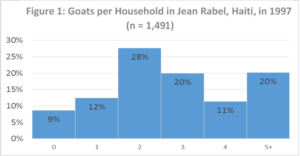
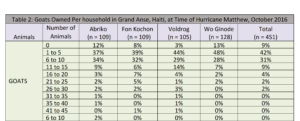
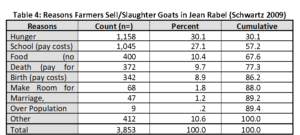
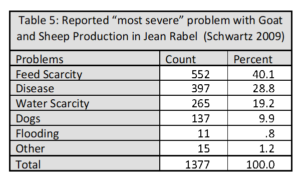
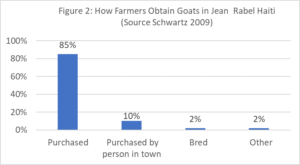
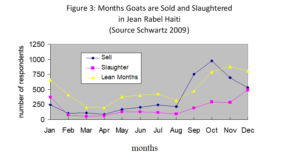
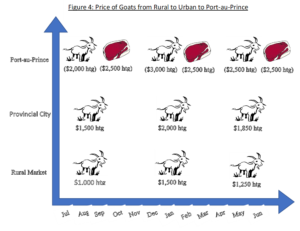
Value Chain Maps
Below are a series of largely self-explanatory goat value chain and marketing maps produced using the MEVMS (Multidimensional Ethnographic Value Chain Mapping Strategy).
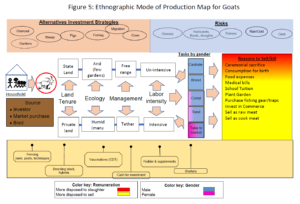
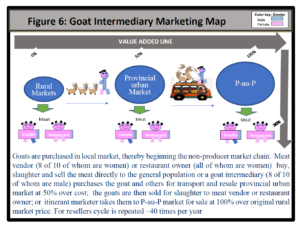
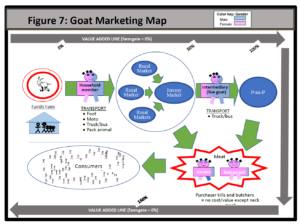

NOTES
[i] FAO (Food And Agriculture Organization Of The United Nations) http://faostat.fao.org/site/339/default.aspx




